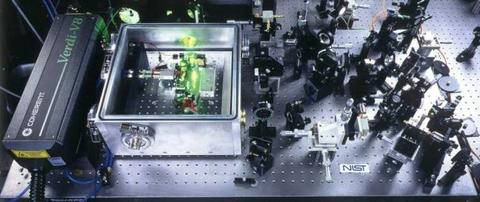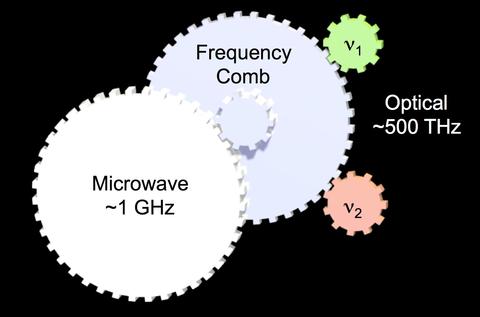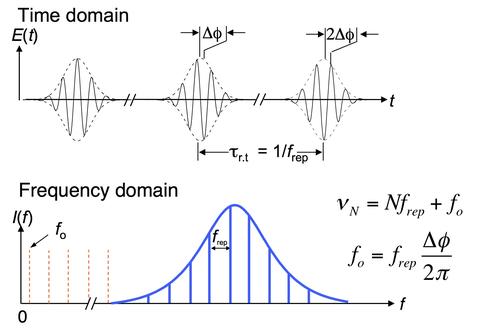Summary
We develop self-referenced mode-locked femtosecond lasers that function as the "gears" of optical clocks. The femtosecond laser clockwork is capable of phase-coherently linking optical frequencies to other optical frequencies and to the microwave domain with demonstrated fidelity below 1 part in 1019.
Description

The self-referenced optical frequency comb, which our NIST/University of Colorado collaboration first demonstrated in 1999, ushered in a revolution in optical frequency metrology. The frequency comb made it possible to directly count optical cycles with femtosecond resolution using a compact and robust system, and it provided the last missing piece to the realization of all-optical clocks. The basic function of the frequency comb in an optical clock is to provide a phase-coherent link between the optical reference frequency at ~500 THz and the more accessible microwave domain. Using a mechanical analogy, we can imagine the frequency comb to be a one-step reduction gear. However, beyond connecting just the optical and microwave domains, it can just as readily measure the ratio of optical frequencies separated by 100's of terahertz.

In reality, the frequency comb is not a set of gears but is the evenly-spaced array of optical modes present in the output of a mode-locked femtosecond laser. From this perspective, the frequency comb is simply the Fourier-domain representation of the repetitive train of femtosecond pulses. The key feature is that the frequency ?n of each mode can be simply described as ?n = Nfrep + fo, where N is a large integer (~105 or 106), frep is the repetition rate of the laser, and fo is the carrier-envelope offset frequency, which is related to the difference of group and phase velocities inside the laser. Because both fo and frep are typically microwave frequencies on the order of 0.1-1 GHz, this expression shows the pathway to connecting optical and microwave frequencies. In practice, frep can be measured by detecting the optical pulse train on a photodiode, while measurement of fo typically requires an octave-spanning spectrum and nonlinear self-referencing. To realize an optical clock, the frequency comb is stabilized to a laser that is referenced to an optical atomic transition (?atom), and the detection of frep provides the down-converted optical frequency frep=?atom/N.

Our research in this area includes: (1) Building and evaluating specialized femtosecond mode-locked lasers (Ti:sapphire, Er:fiber, Yb:fiber, etc.) that must accurately function as a clockwork at and below the 10-18 level; (2) Developing the nonlinear optical systems and frequency control techniques to connect the frequency comb to the atomic references and to actively stabilize the mode-locked laser; and (3) Working together with other members of our group and division to realize optical clocks, evaluate their performance, and distribute their output to make physical measurements.
Major Accomplishments
- Developed and demonstrated the self-referenced frequency comb for the first optical clocks based on laser cooled ions and atoms
- Introduction of the octave-spanning 1 GHz Ti:sapphire laser for comparison and measurement of optical frequency standards
- Measurements of absolute frequencies (and frequency ratios) of Hg+, Al+, Ca, Yb, and Sr optical clocks resulting in stringent constraints of possible variations of fundamental constants

